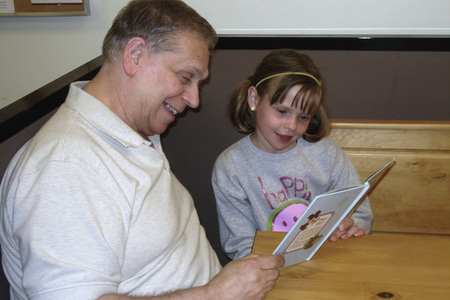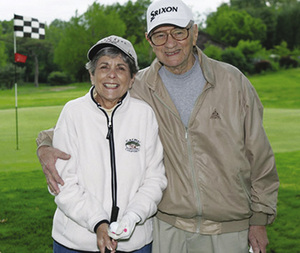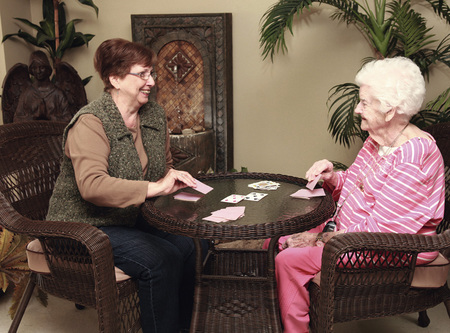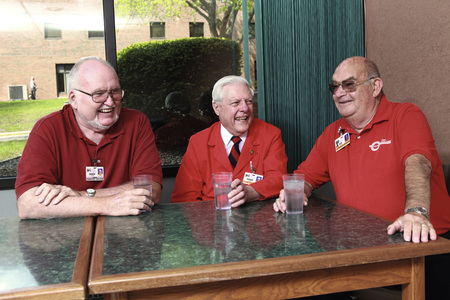Care of the Older Person
Objectives
• Define the key terms and key abbreviations in this chapter.
• Identify the psychological and social changes common in older adulthood.
• Describe the physical changes from aging and the care required.
• Describe housing options for older persons.
• Describe the personal gains and losses related to long-term care.
• Explain how to promote PRIDE in the person, the family, and yourself.
Key Terms
People live longer than ever before. They are healthier and more active. Late adulthood ranges from 65 years of age and older. The oldest-old are 85 years of age and older. Chronic illness is common in older persons. Disability often results. Many older persons have at least 1 disability. Disabilities increase and become more severe with aging. They can interfere with:
• Self-care—bathing, dressing, eating, elimination
• Mobility and getting around one’s home and other settings
• Shopping
Most older people live in a family setting. They live with a spouse, partner, children, brothers or sisters, or other family. Some live alone or with friends. Still others live in assisted living residences or nursing centers. The need for nursing center care increases with aging.
Gerontology is the study of the aging process. Geriatrics is the care of aging people. Aging is normal. It is not a disease. Normal changes occur in body structure and function. The risk for illness, injury, and disability increases. Psychological and social changes also occur. Often changes are slow. Most people adjust well and lead happy, meaningful lives.
There are many myths about aging and older persons. A myth is a widely believed story that is not true. To provide good care, you need to know the facts about older persons and aging. See Box 12-1 for some common myths and facts.
Psychological and Social Changes
Graying hair, wrinkles, and slow movements are physical reminders of aging. These changes threaten self-esteem, self-image, and feelings of self-worth. They also threaten independence.
Social roles change. A parent may rely on an adult child for care. Retirees need activities to replace the work role. Adjusting to the deaths of parents, family members, and friends is common. The person faces his or her own death.
People cope with aging in their own way. How they cope depends on:
Retirement
Age 65 is the common retirement age. Some retire earlier. Others work longer. Retirement allows the person to relax and enjoy life (Fig. 12-1). Travel, leisure, and doing what one wants are retirement “benefits.” Many people enjoy retirement. For others, poor health, disability, and medical bills can make retirement very hard.
Work meets love, belonging, and self-esteem needs. The person feels fulfilled and useful. Friendships form. Co-workers share daily events. Leisure time, recreation, and companionship often involve co-workers. Some retired people have part-time jobs or do volunteer work (Fig. 12-2).
Reduced Income.
Retirement often means reduced income. Social Security may provide the only income.
The retired person still has expenses. House or rent payments continue. Food, clothing, utility bills, and taxes are other expenses. Car expenses, home repairs, drugs, and health care are other costs. So are entertainment and gifts.
Reduced income may force life-style changes. Examples include:
• Limiting social and leisure events
• Buying cheaper food, clothes, and household items
• Living with children or other family
• Avoiding health care or needed drugs
• Relying on children or other family for money or needed items
Severe money problems can result. Some people plan for retirement with savings, investments, retirement plans, and insurance. They are financially comfortable during retirement.
Social Relationships
Social relationships change throughout life. (See Caring About Culture: Foreign-Born Persons.) Children grow up, leave home, and have families. Some live far away from parents. Older family members and friends die, move away, or are disabled. Yet most older people have regular contact with children, grandchildren, family, and friends. Others are lonely. Separation from children is a common cause. So is lack of companionship with people their own age (Fig. 12-3, p. 142).
Many older people adjust to social changes. Hobbies, religious and community events, and new friends help prevent loneliness. Some community groups sponsor bus trips to ball games, shopping, plays, and concerts.
Grandchildren can bring great love and joy (Fig. 12-4). Family times help prevent loneliness. They help the older person feel useful and wanted.

See Focus on Communication: Social Relationships.
Children as Caregivers
Sometimes parents and children change roles. The child cares for the parent. Some older persons feel more secure. Others feel unwanted, in the way, and useless. Some lose dignity and self-respect. Tensions may occur among the child, parent, and other household members. Lack of privacy is a cause. So are disagreements and criticisms about housekeeping, raising children, cooking, and friends.
Death and Grieving
As couples age, chances increase that a partner will die. A person may try to prepare for a partner’s death. When death occurs, the loss is crushing. No amount of preparation is ever enough for the emptiness and changes that result. The person loses a lover, friend, companion, and confidant. Grief may be very great. The person’s life will likely change. Serious physical and mental health problems result. Some lose the will to live. Some attempt suicide.
The surviving spouse may live alone. Others need to decide on housing options. (See “Housing Options,” p. 147.) Some people re-marry or have live-in arrangements with new partners.
Death of a Child.
Sadly, children die. They may be newborns, infants, toddlers, school-age, or older. Death of a child at any age seems to be against the natural order of things. That is, parents should die before their children.
Parents of any age experience great grief when a child dies. As people live longer, some out-live their adult children. Their emotional needs are great. Sadly, often few family and friends are left to provide support and comfort.
Physical Changes
Physical changes of aging happen to everyone (Box 12-2). Body processes slow. Energy level and body efficiency decline. The rate and degree of changes vary with each person. They depend on diet, health, exercise, stress, environment, heredity, and other factors. Changes are slow over many years. Often they are not seen for a long time.
Normal aging does not mean loss of health. Quality of life does not have to decline. The person can adjust to many of the changes.
The Integumentary System
The skin loses elasticity, strength, and the fatty tissue layer. The skin thins and sags. Wrinkles appear. Oil and sweat gland secretions decrease. The skin is dry, itchy, fragile, and easily injured. Brown spots (“age spots,” “liver spots”) are common on the wrists and hands. The skin’s blood vessels are fragile, increasing the risk for:
Loss of the fatty tissue layer affects body temperature. More sensitive to cold, protect the person from drafts and cold. Sweaters, lap blankets, socks, and extra blankets are helpful. So are higher thermostat settings.
Dry, itchy skin is easily damaged. A shower or bath twice a week is enough for hygiene. Partial baths are taken at other times. Mild soaps or soap substitutes clean the underarms, genitals, and under the breasts. Often soap is not used on the arms, legs, back, chest, and abdomen. Lotions and creams prevent drying and itching. Decreased sweat gland secretion may lessen the need for deodorants. See Chapter 22 for hygiene.
Nails become thick and tough. Feet usually have poor circulation. A nick or cut can lead to a serious infection. See Chapter 22 for nail and foot care.
The skin has fewer nerve endings. This affects sensing heat, cold, pressure, and pain. Burns are great risks because of fragile skin, poor circulation, and decreased sensing of heat and cold. Provide socks for cold feet. Do not use hot water bottles and heating pads on feet because of the burn risk.
White or gray hair is common. Hair loss occurs in men. Hair thins on men and women—head, pubic area, and underarms. Women and men may choose to wear wigs. Some color hair to cover graying. Facial hair (lip and chin) may occur in women.
Decreases in scalp oils make hair dryer. Brushing promotes circulation and oil production. Shampoo frequency usually decreases with age. It is done as needed for hygiene and comfort.
Skin disorders and skin cancer increase with age. They rarely cause death if treated early. Prolonged sun exposure is a cause of skin cancer.
Changes to the integumentary system can be seen. Gray hair, hair loss, brown spots, wrinkles, and sagging skin are some examples. These changes can affect self-esteem and body image.
The Musculo-Skeletal System
Muscle cells decrease in number. Muscles atrophy (shrink). They decrease in strength.
Bones lose minerals, especially calcium. Bones lose strength, become brittle, and break easily. Sometimes just turning in bed can cause fractures (broken bones).
Vertebrae shorten. Joints become stiff and painful. Hip and knee joints flex (bend) slightly. These changes cause gradual loss of height and strength. Mobility also decreases.
Activity, exercise, and diet help prevent bone loss and loss of muscle strength. Walking is good exercise. Exercise groups and range-of-motion exercises are helpful (Chapter 30). A diet high in protein, calcium, and vitamins is needed.
Bones can break easily. Protect the person from injury and falls (Chapters 13 and 14). Turn and move the person gently and carefully (Chapters 18 and 19). Some persons need help and support getting out of bed. Some need help walking.
The Nervous System
Nerve cells are lost in the brain and spinal cord. Nerve conduction and reflexes slow. Responses are slower. For example, an older person slips. The message telling the brain of the slip travels slowly. The message from the brain to prevent the fall also travels slowly. The person falls.
Blood flow to the brain is reduced. Dizziness may occur, increasing the risk for falls. Practice measures to prevent falls (Chapter 14). Remind the person to get up slowly from bed to chair or standing. This helps prevent dizziness (Chapter 30).
Changes occur in the brain. This affects personality and mental function. So does the reduced blood flow to the brain. Memory is shorter. Forgetfulness increases. Responses slow. Confusion, dizziness, and fatigue may occur. Older persons often remember events from long ago better than recent ones. When mentally active and involved in current events, older people show fewer personality and mental changes. (See Chapter 49.)
Sleep patterns change. Falling asleep is harder. Sleep periods are shorter. Older persons wake often at night and have less deep sleep. Less sleep is needed. Loss of energy and decreased blood flow may cause fatigue. They may rest or nap during the day. They may go to bed early and get up early.
The Senses.
Aging affects touch, smell, taste, sight, and hearing.
Touch.
Touch and sensitivity to pain and pressure are often reduced. So is sensing heat and cold. These changes increase the risk for injury. The person may not notice painful injuries or diseases. Or the person feels minor pain. You need to:
• Protect older persons from injury (Chapters 13 and 14).
• Follow safety measures for heat and cold (Chapter 38).
• Check for signs of skin breakdown (Chapters 22, 36, and 37).
• Give good skin care (Chapter 22).
• Prevent skin tears (Chapter 36) and pressure ulcers (Chapter 37).
Stay updated, free articles. Join our Telegram channel

Full access? Get Clinical Tree





